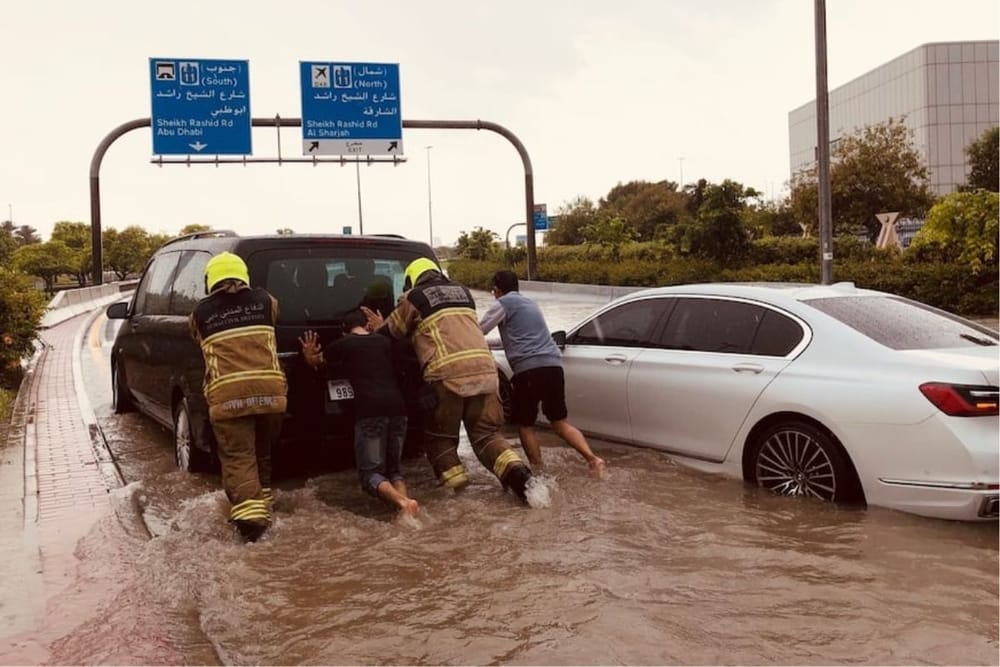On Tuesday, storms flooded the UAE, resulting in the most rainfall the country has seen in 75 years. This is a record since climate data started being kept in 1949.
There was flooding across homes and buildings across the nation, with highways being submerged and in some cases completely wiped away.
Given the weather-related damage that has been done to cars and property, it's critical to know what resources are available to file an insurance claim in order to minimize costs and guarantee prompt repair.
Insurance coverage in UAE
According to Article 1026 of the Civil Transactions Law, insurance acts as a legally enforceable contract between the insured and the insurance provider to reduce risks.
In the United Arab Emirates, the majority of insurance policies, including home and auto insurance, often cover rain-related damages to buildings and cars.
Rain and natural disaster-related damages, such as floods and heavy rain, are usually covered by comprehensive insurance plans.
Policies for homes and property that provide insurance against all hazards, including natural disasters, frequently cover rain-related damages.
Importance of policy examination
It’s crucial to carefully review the language of the insurance policy to understand the scope of coverage and any exclusions.
Exclusions may exist for specific situations, including force majeure events, which are exceptional circumstances beyond anyone’s control.
Force majeure events and insurance claims
Force majeure events, such as natural disasters, can impact insurance claims.
Understanding the clause: Force majeure is a legal concept that refers to unforeseeable circumstances or events that are beyond the control of parties involved in a contract, making it impossible for them to fulfill their obligations.
These events are typically considered to be natural disasters, acts of war, strikes, or other events that are considered to be beyond human control.
In contractual agreements, a force majeure clause may excuse one or both parties from fulfilling their obligations under certain circumstances, protecting them from liability for failing to perform due to these unforeseen events.
If a force majeure event is not covered by the insurance policy, the insurance provider may not be liable for damages, as per Article 287 of the UAE Civil Transactions Law.
However, if the policy explicitly includes coverage for force majeure events, such as natural disasters, rain damage, and other events the insurance provider may be legally obligated to indemnify the insured.
Legal precedents
The application of force majeure in insurance claims was emphasised in a significant ruling by the Abu Dhabi Court of Cassation in 2021.
The court clarified that force majeure must be the sole cause of damage for exemption.
Challenges with claims
Insurance claims can be contested, especially if the damage resulted from the insured’s negligence or lack of care.
For instance, leaving a vehicle parked in a flood-prone area or driving through a flooded zone may lead to challenges in claiming insurance coverage.
Understanding the intricacies of insurance coverage, including policy terms, exclusions, and legal implications, is essential for making successful insurance claims for damages caused by heavy rain and related weather events.
Claim car insurance
Obtain a ‘To Whom It May Concern’ certificate online:
- Visit the Dubai Police website or use the Dubai Police app to apply for the certificate.
- Provide details about your damaged vehicle and attach photos of the damage.
- Pay the fee
- Receive the certificate digitally within five minutes.
- Inform your insurance broker
In the event of a vehicle breakdown caused by severe weather conditions, you now have the option to request a “To Whom it May Concern” certificate through the official Dubai Police website or mobile app.
In the event of a vehicle breakdown caused by severe weather conditions, you now have the option to request a "To Whom it May Concern" certificate through the official Dubai Police website or mobile app.#DubaiPoliceService pic.twitter.com/c3qYPpUZ1Y
— Dubai Policeشرطة دبي (@DubaiPoliceHQ) April 17, 2024
Contact your insurance broker promptly to report the damage.
- Seek assistance in navigating the claims process and obtaining necessary instructions.
Document the damage
- Take photographs or videos of the weather-related damage as evidence. This documentation will help assess the extent of the damage accurately.
Submit required documents
- Provide copies of your vehicle registration card and a valid driving license.
Obtain the original police report describing the damage and submit it promptly. - Obtain repair estimates
- Share these estimates with your insurance broker for evaluation.
Follow the claims process
- Your insurance broker will guide you through the necessary paperwork and steps to complete your claim.
- Provide all required documents promptly and accurately to expedite the process.
Home insurance
Home insurance, also known as homeowners’ insurance or property insurance, serves as a financial safety net for protecting your home.
In Dubai, home insurance safeguards your property from a range of risks, including damage caused by fire, theft, vandalism, and natural disasters.
Additionally, it provides coverage for personal liability claims arising from accidents on any type of property.
Types of Home Insurance
Building Insurance:
- Building insurance covers the physical structure of your home, including walls, roof, foundation, built-in fixtures, and structural components.
- It offers protection against various risks such as fire, lightning, explosions, earthquakes, vandalism, and theft affecting the structural integrity of your property.
- Particularly crucial for homeowners, building insurance safeguards their significant property investment.
Contents Insurance:
- Contents insurance focuses on protecting personal belongings and possessions inside your home, such as furniture, appliances, jewellery, and other valuables.
- It covers theft, damage, and loss of these items due to various factors, including fire, theft, vandalism, and natural disasters.
- Essential for safeguarding personal property, contents insurance ensures protection for belongings against damage or loss.
Submitting a Home Insurance Claim
Step 1: Report Incident
- Report the damage to your home or its contents, along with the required documents.
Step 2: Claim Assessment
- Once reported, we initiate your claim process.
- We record incident details, assess your case, and provide guidance on next steps.
- Depending on the nature of the loss, a Loss Adjuster may be appointed for investigation or a survey may be arranged by ADNIC Engineering Services Dept.
Step 3: Receive Claim Reference Number
- Upon claim opening, expect to receive an SMS within a couple of days containing a claim reference number.
- This number, along with contact details of your nearest repair workshop, will be provided.
- Use the claim reference number to track your claim status.
Required Documents
- Ensure you have the necessary details and documents ready to report the incident smoothly.
- For home insurance claim notification, you will need:
- Policy number
- Police report (if applicable)
- Time, date, and location of incident
- Description of what happened
- Estimated value of loss
- Claim form
- Additional documentation may be required based on the loss.
Where to Submit Your Claim
- Report the incident via phone, fax, email, or online channels for convenience.
News Source: Gulf Business









